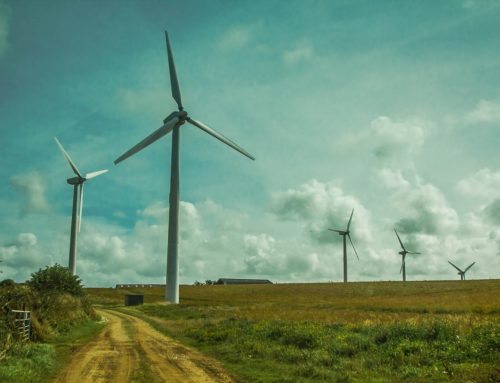by Ian Cessford and Rob Reid
8 minute read
It’s been a year since the then Secretary of State for Energy and Climate Change, Amber Rudd, made her ‘policy reset’ speech setting out a new direction for UK energy policy. Since then, we’ve had leadership, ministerial, departmental and policy changes: it seems that we already need to press reset again and check that Government is designing and implementing policies that will cost-effectively deliver its emissions reduction targets and industrial strategy goals in a post-Brexit UK.
Despite the turbulent times, the Government showed continued commitment to the Climate Change Act by agreeing to the 5th Carbon Budget and its 57% reduction in emissions by 2032. This was welcomed by the Committee on Climate Change (CCC) whose latest progress report also found that emissions have fallen by 13% in the past three years to 38% below 1990 levels.
On budget
We have already met the 1st Carbon Budget and progress to date means the 2nd (29% below the 1990 base year level for 2012-2017) and 3rd (a 36% reduction compared with the base year across 2017-2022) are probably in the bag. With these achievements, the Government might expect high marks for its efforts.
However, as we look further ahead the details contain a fair bit of devilry. Emissions are currently projected to exceed the 4th Carbon Budget by 10% and the 5th Carbon Budget by 18%. So far, emissions reductions have been almost exclusively delivered by the power sector (via closure of coal-fired power stations), and the CCC reports that there is minimal evidence of progress in the industrial sector. That’s despite energy efficiency being one of the cheapest ways to cut emissions. The Government recognises the importance of the low carbon agenda in industrial strategy, but will need to ‘walk the talk’ through the energy efficiency policies and programmes it announces in its Emissions Reduction Plan, due in February 2017.
In designing the next generation of policies, it is critical that BEIS learns the lessons of the recent Electricity Demand Reduction (EDR) Pilot. Importantly, we would argue that the challenges of encouraging energy efficiency won’t be addressed simply by making more money available; rather, the support needs to be provided in ways that fit the way in which businesses make decisions.
The EDR provides incentives to organisations to replace inefficient electrical equipment with more efficient alternatives, with the aim of delivering peak demand savings that reduce the need for standby generation capacity. Eunomia has been providing technical support to the pilot, giving us a close-up view of the barriers that businesses have faced in trying to improve energy efficiency – and why the successful projects were ones with short payback periods and minimal impact on business operations. Not all energy efficiency measures can follow this model, even if they would deliver considerable direct and indirect benefits. In practice, the majority of successful projects involved the installation of LED lighting.
Decision theory
In larger organisations, energy efficiency investment decisions will typically be made as part of capital expenditure funding rounds that could take place as frequently as monthly, but in many cases are annual. EDR registration and application deadlines coincided with the winter peak period; and while there was a rationale for this, the strict deadlines are likely to be a poor fit with the timing of many businesses’ investment decisions. Some potential applicants that could have used EDR funding to improve their project viability were therefore not in a position to apply.
Furthermore, investments in energy efficiency measures have to compete against other projects. Businesses choose the investments that perform best, and often measure this using a simple payback calculation over a period of five years or less. The net contribution from the EDR might have been relatively small, say 10% of the capital expenditure on the new energy-efficient equipment, but this could tip the balance in favour of the energy efficiency project over competing calls on capex.

Easily LED: can future business energy saving support schemes deliver more challenging projects? Photo: Razor512 (CC BY 2.0), via Flickr.
Another influence on energy efficiency investments is perception of risk. As highlighted above, whether or not supported by the EDR pilot, there has been considerable investment by industry in measures such as LED lighting, which can be implemented swiftly and with no impact on the core business. Measures which might temporarily halt or constrain production or normal operation are far less popular, even when they might deliver significantly lower future operating costs. On the EDR pilot, such commercial risk was compounded by ‘application’ risk. EDR used an auction process: applicants were required to bid on a £/kW saved basis, with no guarantee of being funded, making the decision to invest resources just in entering the process inherently risky.
Organisations that are motivated to invest in energy efficiency measures may do so to deliver upon Corporate Social Responsibility (CSR) goals or to help implement Energy Management Systems (EMS) such as ISO50001. However, such goals are not necessarily reflected in evaluation criteria that form part of internal investment appraisals. In the course of our work, we encounter many very crude submissions, covering only the costs of equipment, and benefits from avoided energy costs. Other indirect benefits, such as improvements to the working environment, increased staff morale and higher production levels, which might have indirectly improved payback, are not typically accounted for in the business cases, thereby affecting their viability against competing non-energy projects.
ESOS fables
ESOS requires that non-SMEs undertake four-yearly energy audits to comply with the EU Energy Efficiency Directive, but only very few have implemented changes as a result. In its current form, it appears to be more of an Energy Savings Missed-Opportunities Scheme. Policy initiatives that promote the integration of EMS and continuous improvement programmes would more likely deliver savings in the long-term, and are already being promoted by some suppliers in the form of energy performance contracts.
We are clearly going to need a new set of policies if we’re going to meet the 4th and 5th Carbon Budgets’ goals. The Government has the opportunity to seize this potential through its Emissions Reduction Plan. However it is taking its time over publishing the plan and has stated it will consult with businesses and wider stakeholders on its policies and programmes. This is encouraging, but the Government needs to use this time wisely and not create further unnecessary delays in getting on with implementing policies.
Critically, the Government needs to ensure that the measures it introduces reflect an understanding of businesses’ investment processes, and the needs of different audiences such as the energy managers who may initiate energy saving ideas and the corporate boards whose approval may be needed for investment decisions. That means providing tailored information and education to equip those responsible for energy efficiency investments with the tools to develop credible business cases and make informed investment decisions based on the merits of a technical solution.
In addition, as investment appraisals typically favour projects with a maximum five-year (or often two-year) payback, policies should take this into account, especially where Government support is being provided. In these instances, support needs to be set at a level that reflects the market maturity of the energy efficient technology. For technologies such as LED lighting that are now mass market, is it still appropriate for government to provide funding? Government support should be targeted towards other technologies, such as commercial chillers, motors or even more integral elements of manufacturing equipment that are more costly and potentially disruptive, but also deliver significant savings.
Pressing reset
Adopting a joined up approach to policies would provide a more coherent picture for organisations seeking to invest in more efficient solutions. For example, the Government is currently committed to the next ESOS deadline in 2019. Whatever policy mechanisms are put in place, assuming these incorporate some kind of financial support, it would make sense for this to coincide with when organisations are reporting against ESOS obligations such that energy efficiency is front of mind. This would allow both the reporting and subsidy mechanisms to be considered as a package.
As part of this process, government must also engage with the energy efficiency industry to leverage its help. Ultimately, the suppliers and installers of energy efficient equipment have most to gain from their technologies being successfully implemented through policy interventions. It serves their interests to promote uptake through their customer base – yet this did not occur with the EDR pilot. They need to be encouraged to develop and promote products which are compliant with specific funding streams and/or develop dedicated financing packages in partnership with specialised financial service providers.
Policies should also be designed to enable the ‘aggregator’ market to grow. Such models have been instrumental in boosting the solar PV market and aggregators are increasingly involved in grouping generation capacity to provide ancillary services to National Grid. Essentially, such organisations minimise the administrative burden and risk for participants, thus bringing more into the market and subsequently enabling aggregators to deliver economies of scale through equipment installation across a portfolio of projects.
Unless government learns the lessons of the last round of business energy efficiency policies, it will be doomed to repeat the limited results these achieved. This time it is essential that industrial energy efficiency makes a significant contribution to carbon reductions. We won’t be in a position to meet our carbon budget targets for the 2020s through changes in the power generation system alone.
Ian Cessford and Rob Reid







Leave A Comment